Monday, February 19th 2018

Intel Unveils Discrete GPU Prototype Development
Intel is making progress in its development of a new discrete GPU architecture, after its failed attempt with "Larrabee" that ended up as an HPC accelerator; and ancient attempts such as the i740. This comes in the wake of the company's high-profile hiring of Raja Koduri, AMD's former Radeon Technologies Group (RTG) head. The company unveiled slides pointing to the direction in which its GPU development is headed, at the IEEE International Solid-State Circuits Conference (ISSCC) in San Francisco. That direction is essentially scaling up its existing iGPU architecture, and bolstering it with mechanisms to sustain high clock speeds better.
The company's first 14 nm dGPU prototype, shown as a test-chip at the ISSCC, is a 2-chip solution. The first chip contains two key components, the GPU itself, and a system agent; and the second chip is an FPGA that interfaces with the system bus. The GPU component, as it stands now, is based on Intel's Gen 9 architecture, and features a three execution unit (EU) clusters. Don't derive numbers from this yet, as Intel is only trying to demonstrate a proof of concept. The three clusters are wired to a sophisticated power/clock management mechanism that efficiently manages power and clock-speed of each individual EU. There's also a double-clock mechanism that doubles clock speeds (of the boost state) beyond what today's Gen 9 EUs can handle on Intel iGPUs. Once a suitable level of energy efficiency is achieved, Intel will use newer generations of EUs, and scale up EU counts taking advantage of newer fab processes, to develop bigger discrete GPUs.More slides follow.
Source:
PC Watch
The company's first 14 nm dGPU prototype, shown as a test-chip at the ISSCC, is a 2-chip solution. The first chip contains two key components, the GPU itself, and a system agent; and the second chip is an FPGA that interfaces with the system bus. The GPU component, as it stands now, is based on Intel's Gen 9 architecture, and features a three execution unit (EU) clusters. Don't derive numbers from this yet, as Intel is only trying to demonstrate a proof of concept. The three clusters are wired to a sophisticated power/clock management mechanism that efficiently manages power and clock-speed of each individual EU. There's also a double-clock mechanism that doubles clock speeds (of the boost state) beyond what today's Gen 9 EUs can handle on Intel iGPUs. Once a suitable level of energy efficiency is achieved, Intel will use newer generations of EUs, and scale up EU counts taking advantage of newer fab processes, to develop bigger discrete GPUs.More slides follow.
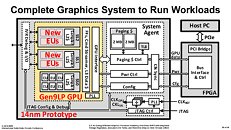
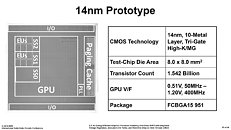
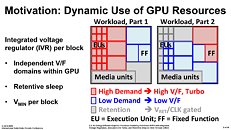
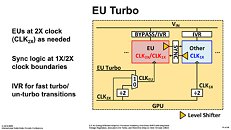
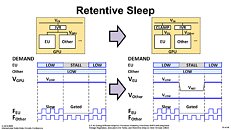
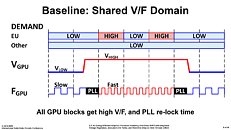
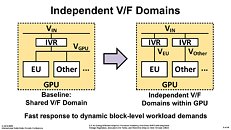
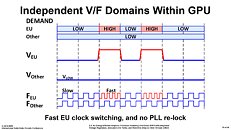
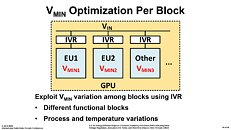
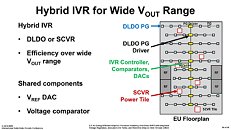
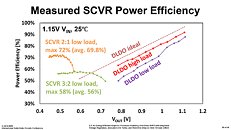
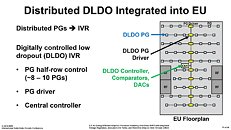
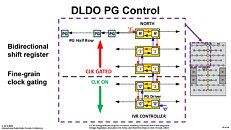
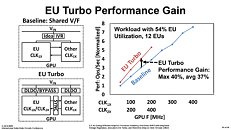


65 Comments on Intel Unveils Discrete GPU Prototype Development
On the other side reading here I can see a logic and argument of this work is to perhaps also provide a offshoot for iGPU perpetuation for the consumer CPU against AMD APU's. The more I read the more I don't see this about a discrete Graphic gaming product for either desktops or laptops, as I don't think Intel wants in on maintaining gaming drivers.
Raja is tasked to lead and maintain clear focus and keep engineers on task. He's less about actual designing but more using his preeminence on building partnerships and the development of trends in such moving markets.
From what I can personally make out from 1 the Hype and 2 the pics above (notably the 1st one), is that Intel do indeed intend to make a g-card to compete with NVIDIA and AMD. The 1st pic shows a PCI-E interface via/ with the FPGA. Thats how yours and my g-cards work BTW. Also the title says ''Discrete GPU''. Our cards (seperate not intergrated ones, e.g GTX 1070 etc...) are Discrete GPU's.
AND! You reckon Intel cant compete with NVIDIA? Intel money wise have 9x times more Billion $ dollars than NVIDIA, have been around for twice as long - 50 years compared to 25 and have chip making research and capabilities coming out of every orifice that FAR surpasses NVIDIA or AMD. True the big 2 are further along R&D wise in this particular speciality. But Intel wanna make more dollar and have the dollar and previous experience in order to at least give it a shot.
So maybe Intel may will go up against the big 2 and maybe, finally we will have more choice! It might take a long while though and as CKBRYANT above has pointed out, Intel will most likely start with Datacenters and AI processing. You never know, perhaps their first GPU will be a Mining one! Lols, I bloody hope not...
There is no reason any company should be pigeonholed. Proper application of resources and recruitment of Subject Matter Experts allows expansion to other fields, especially similar ones like GPU’s.
But they're a CPU company and anything else will be a secondary business and be treated as one.
Otherwise they'd still be making discrete GPUs to this day.
they don't have CPUs as a standalone chapter in their revenue stream. Whether it's "PC client group", "client computing group" and "data center group" or whatever, they're looking at these as more or less complete platforms.
Whether they've build cheap, weak, embeddable solutions by themselves or licensed them from a third party, Intel has been dealing with graphics chips for decades. Arguing now that because they've traditionally used those as IGPs they cannot possibly build a decent discrete graphic card is a bit far fetched, imho.